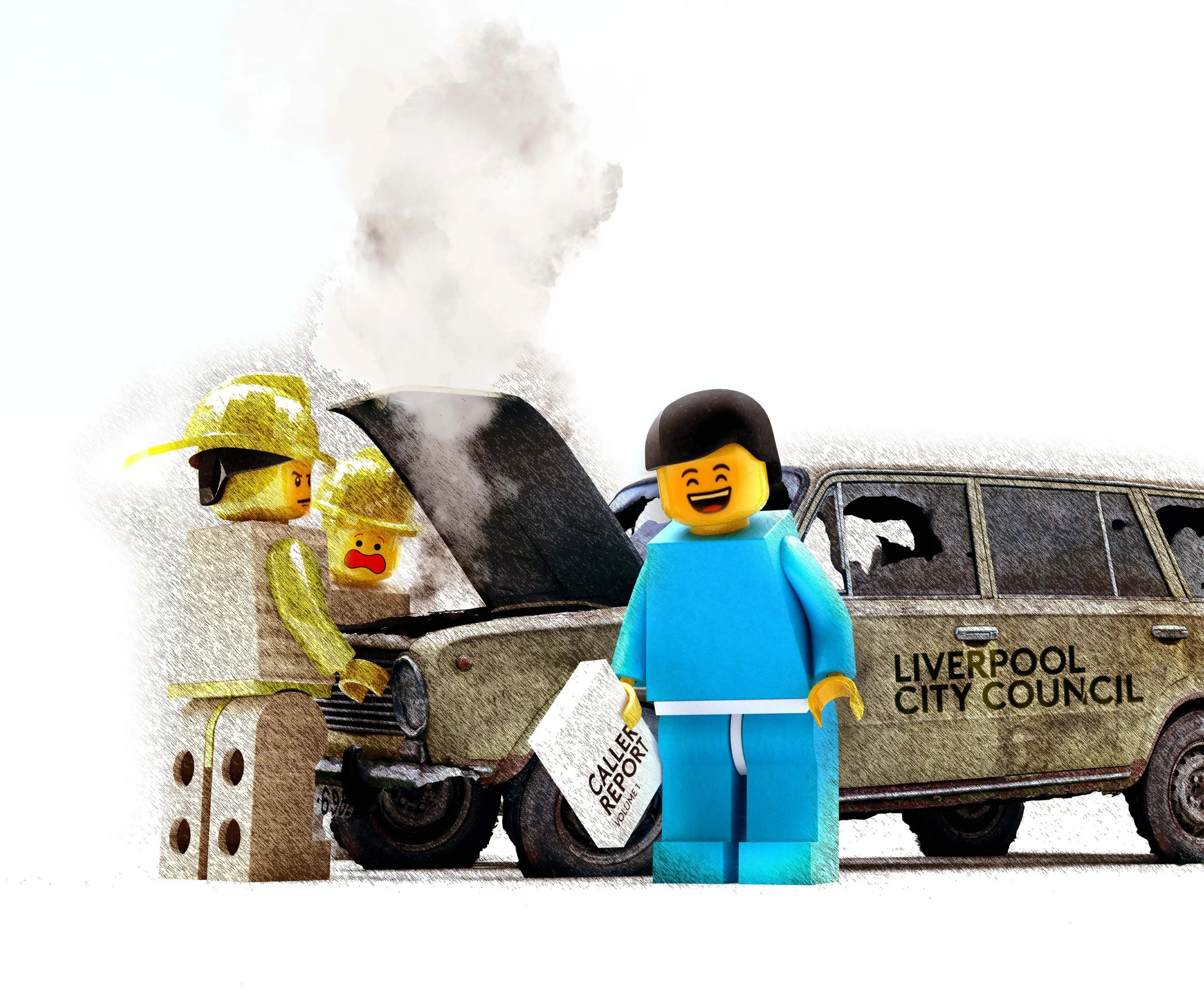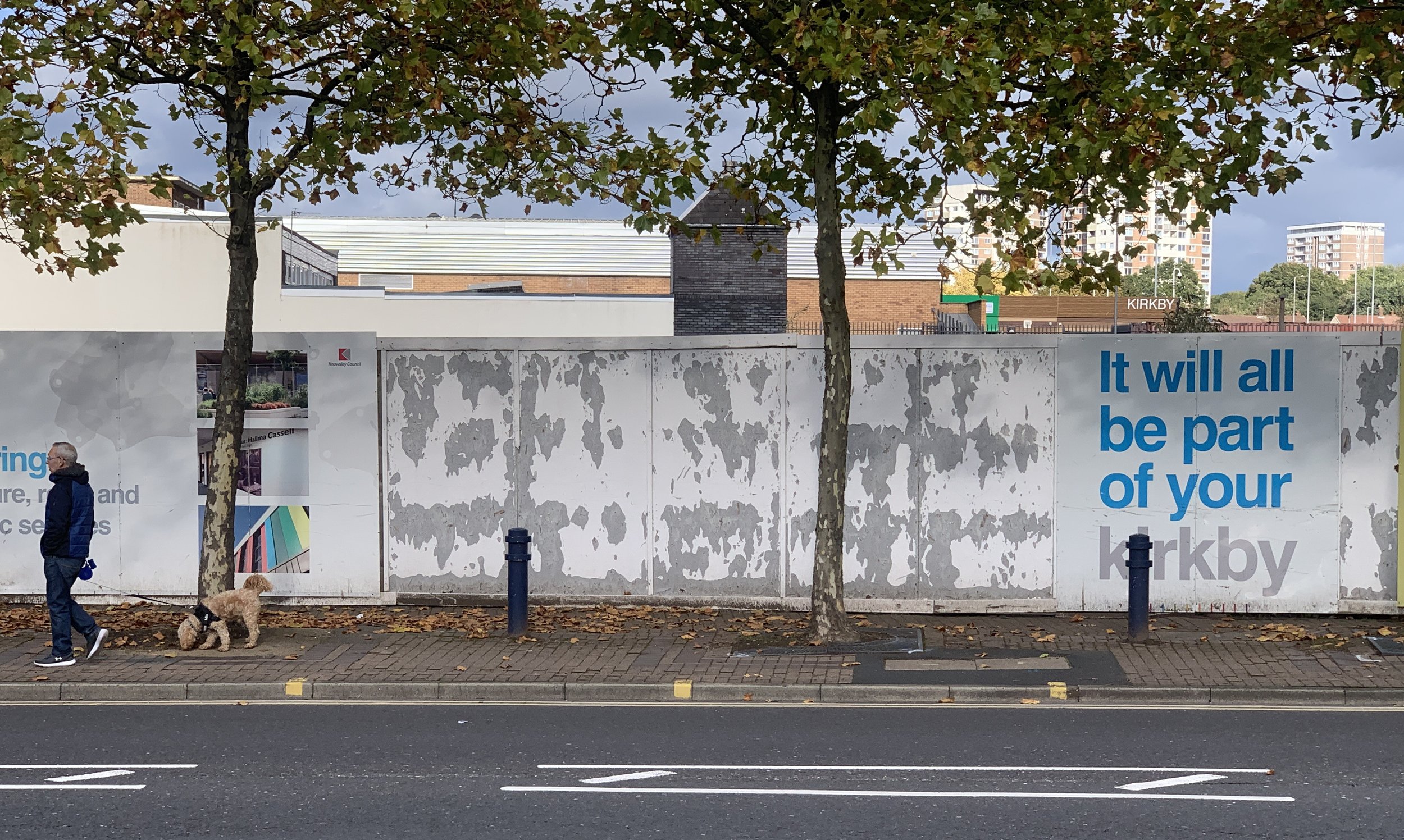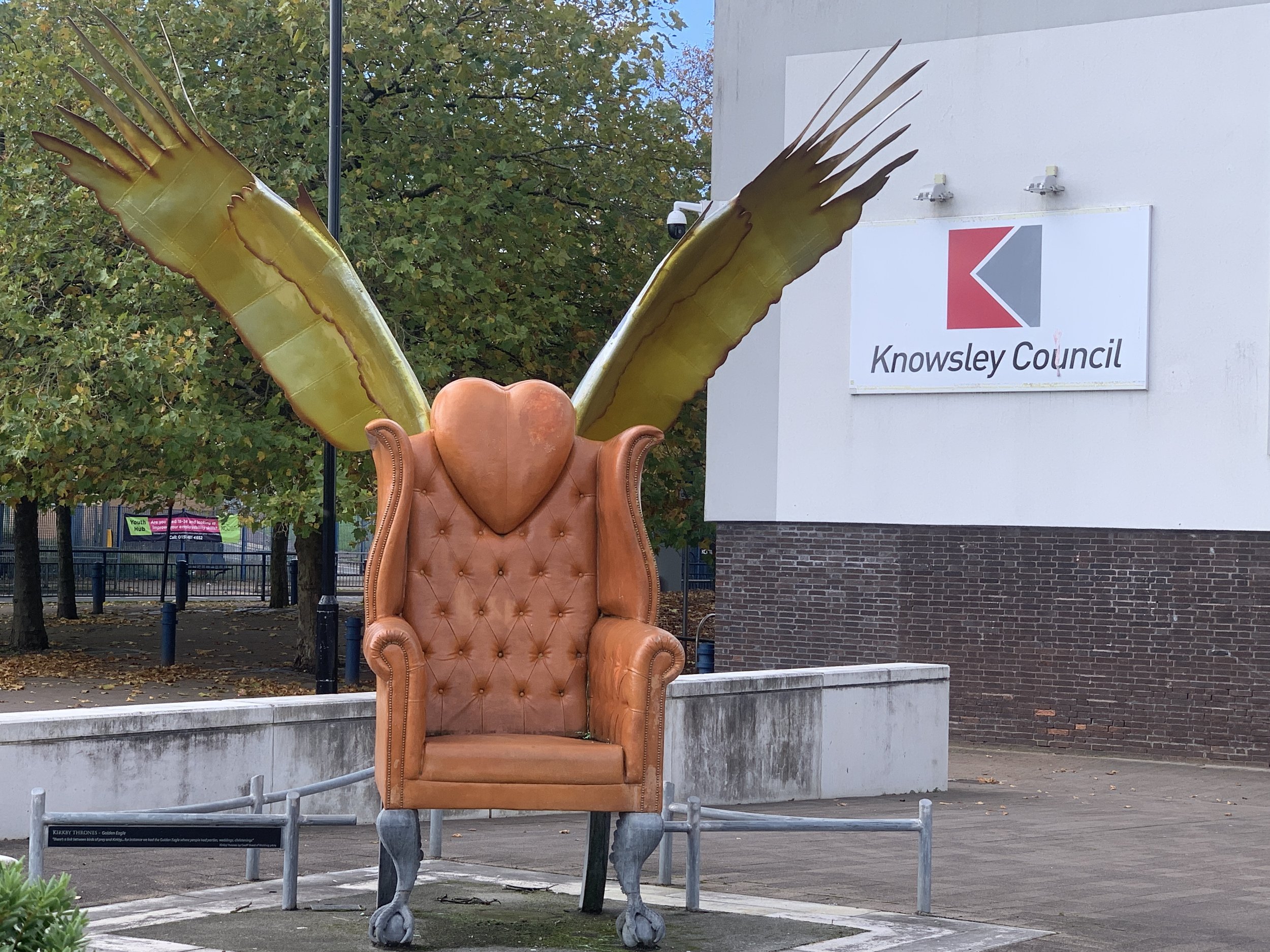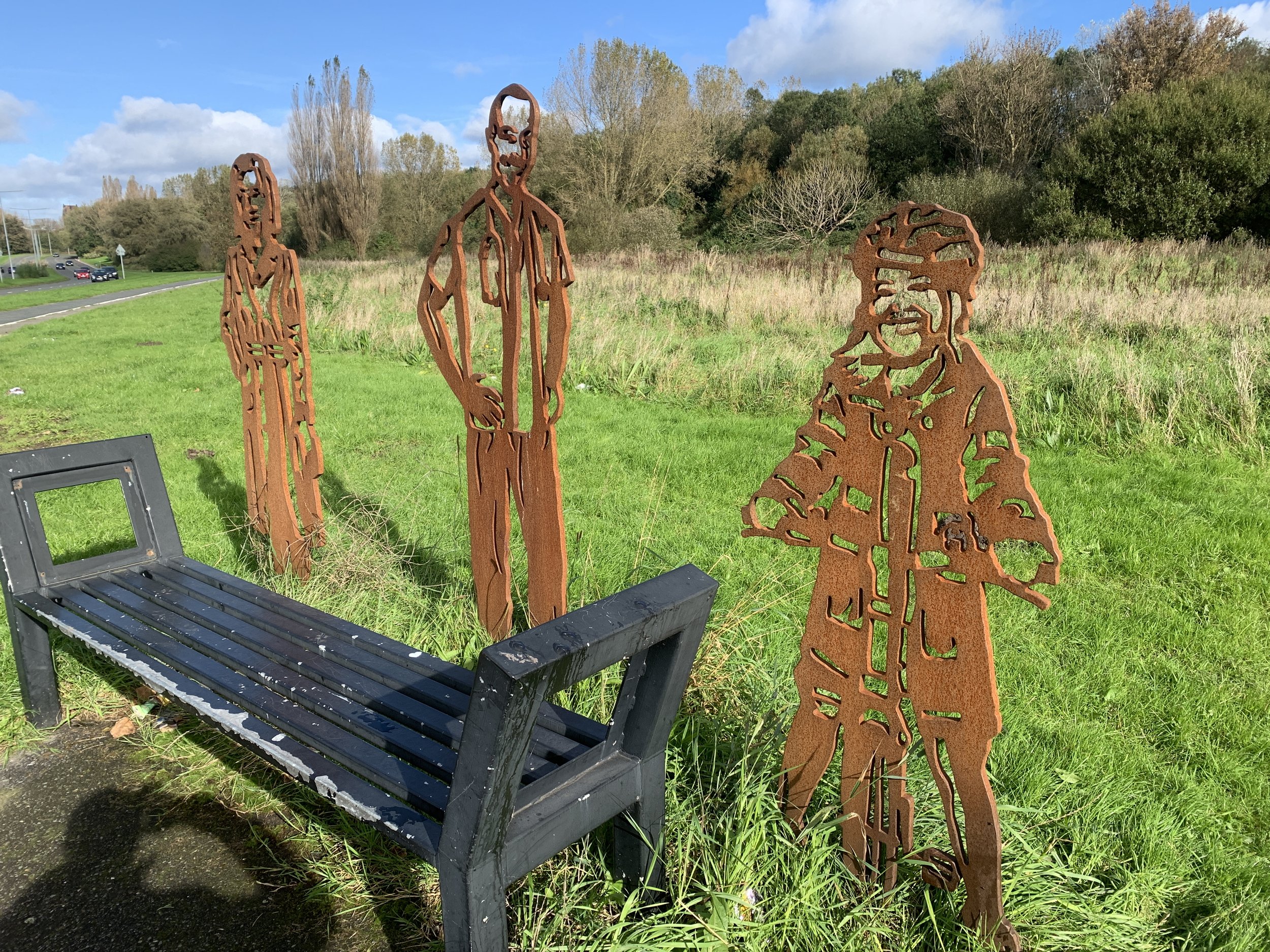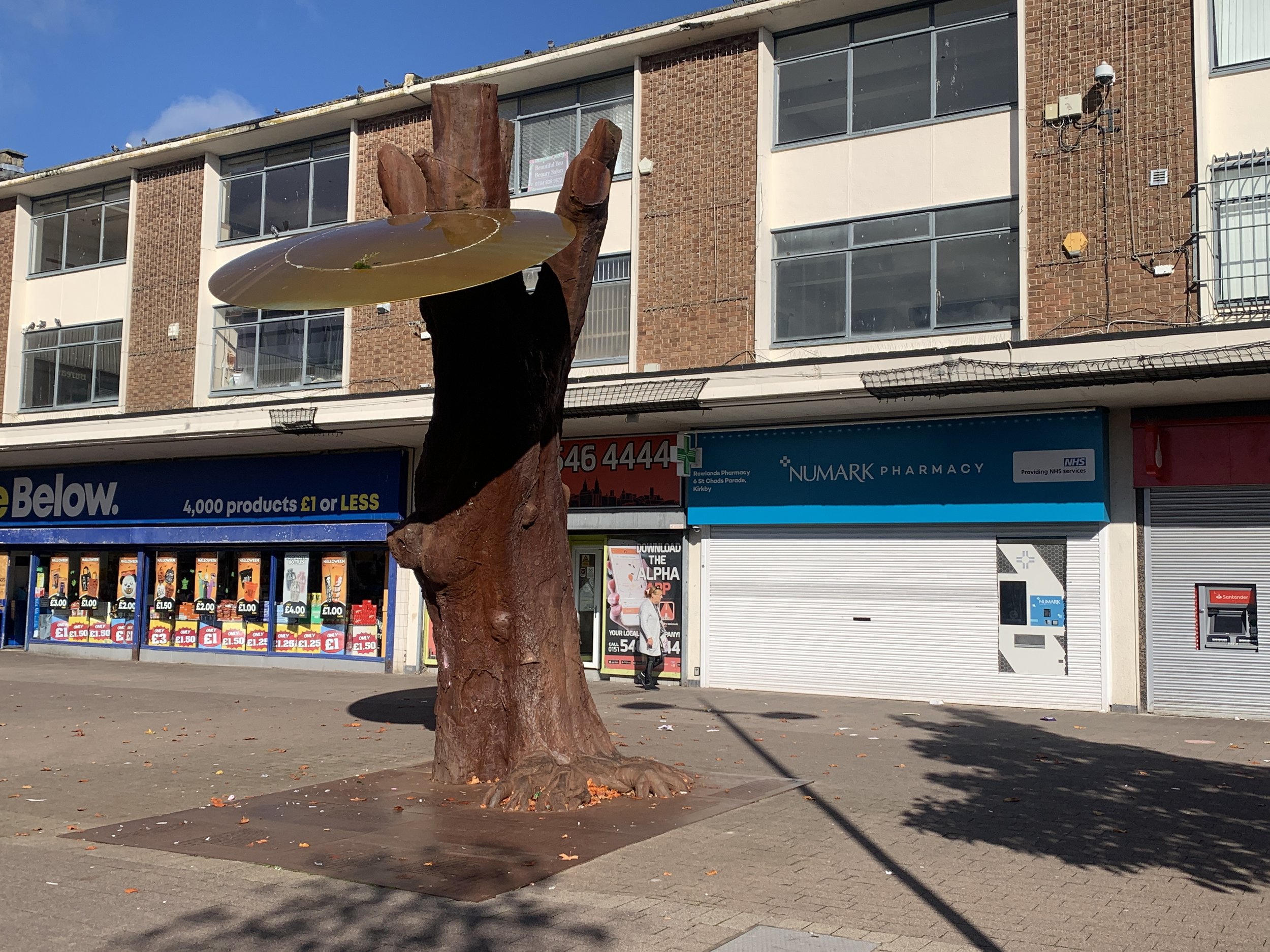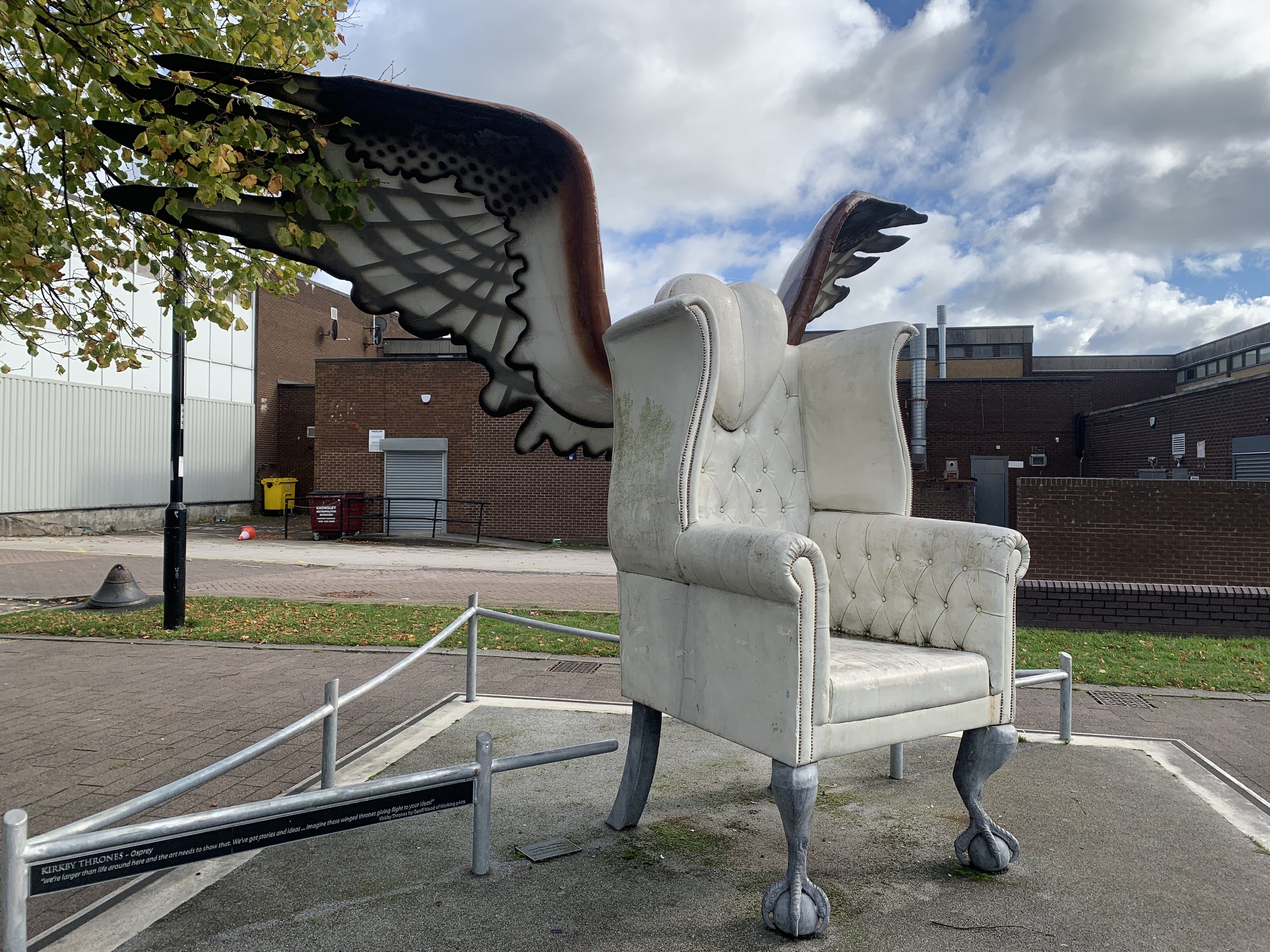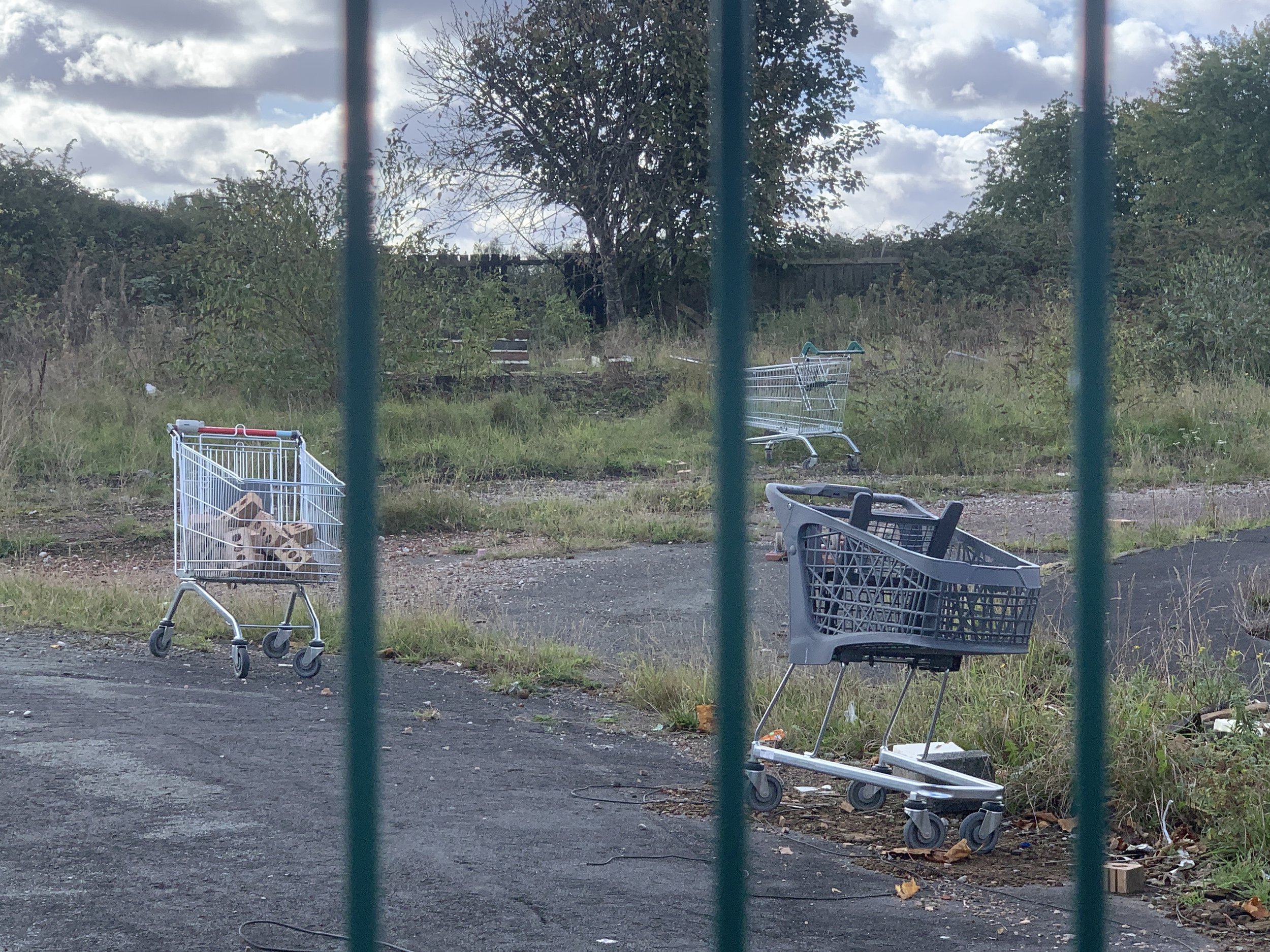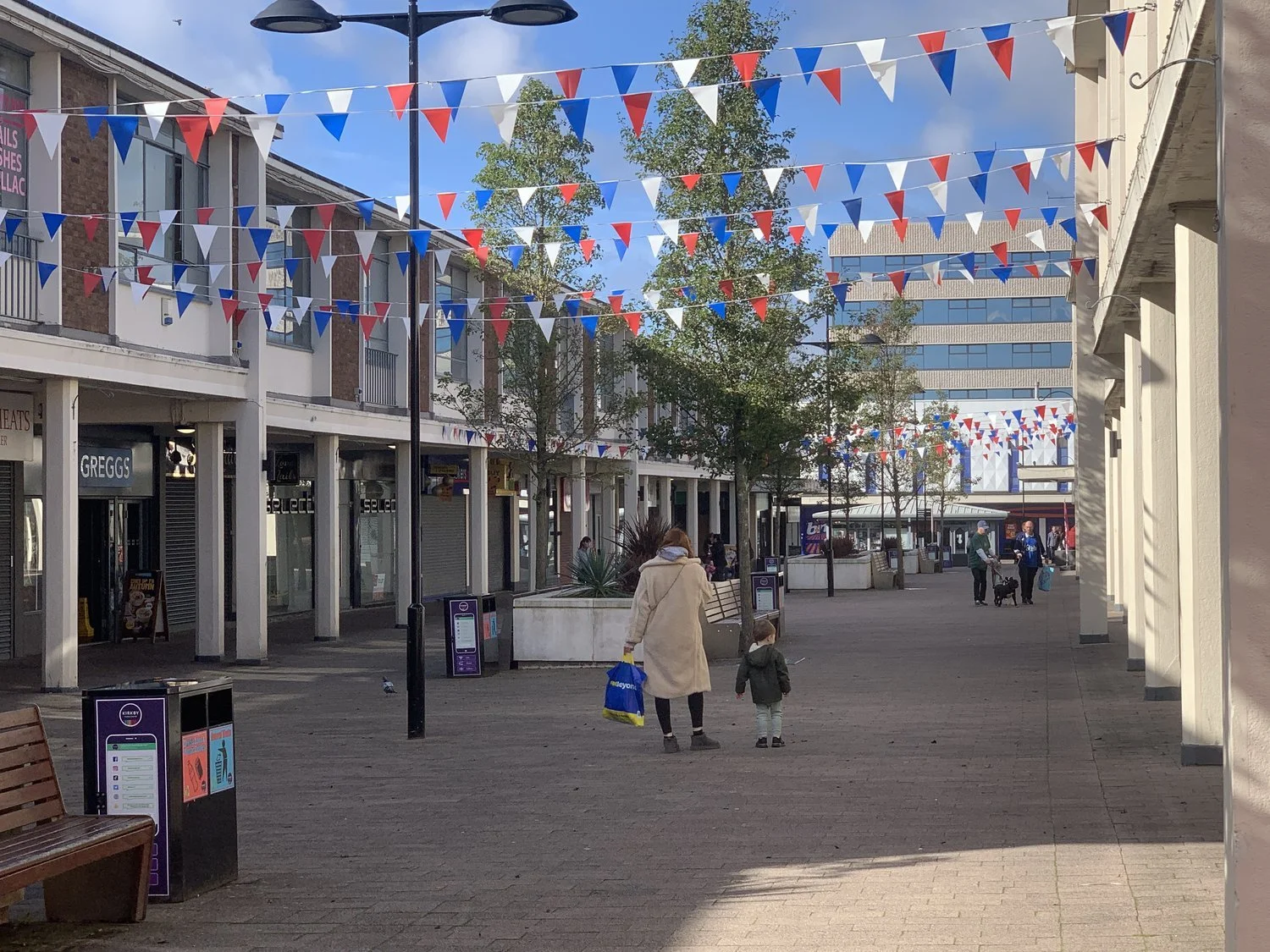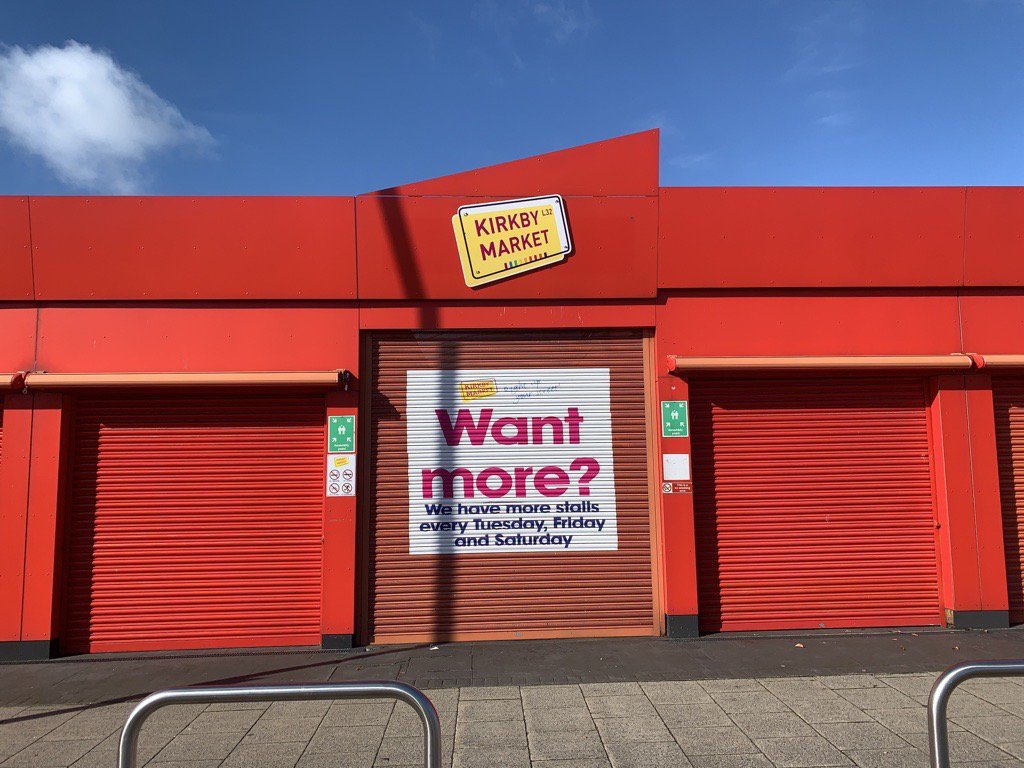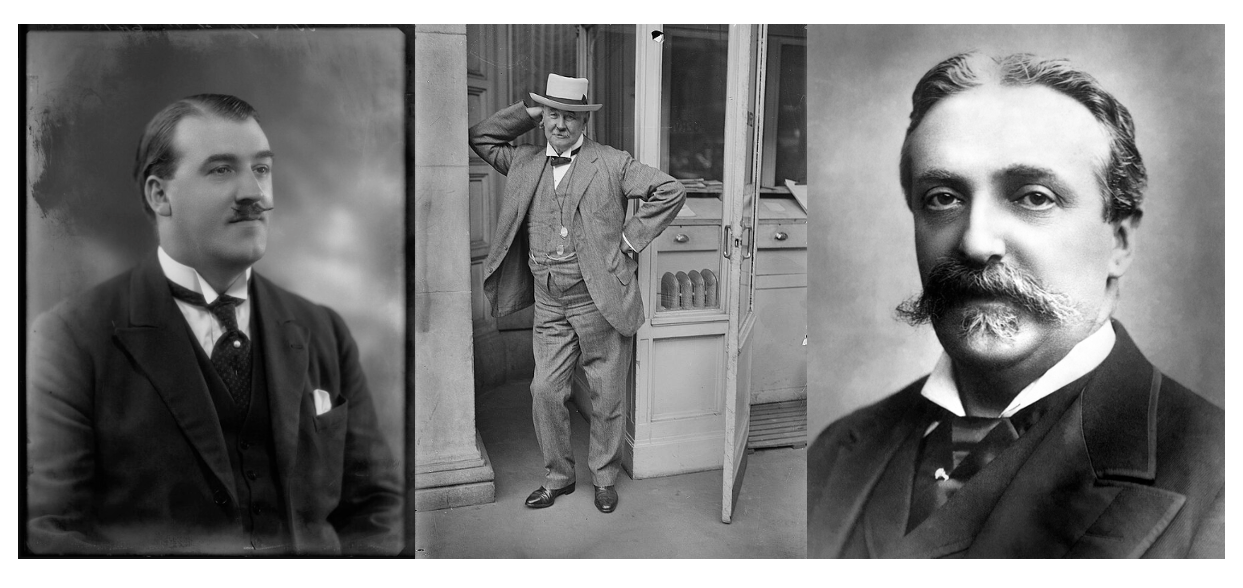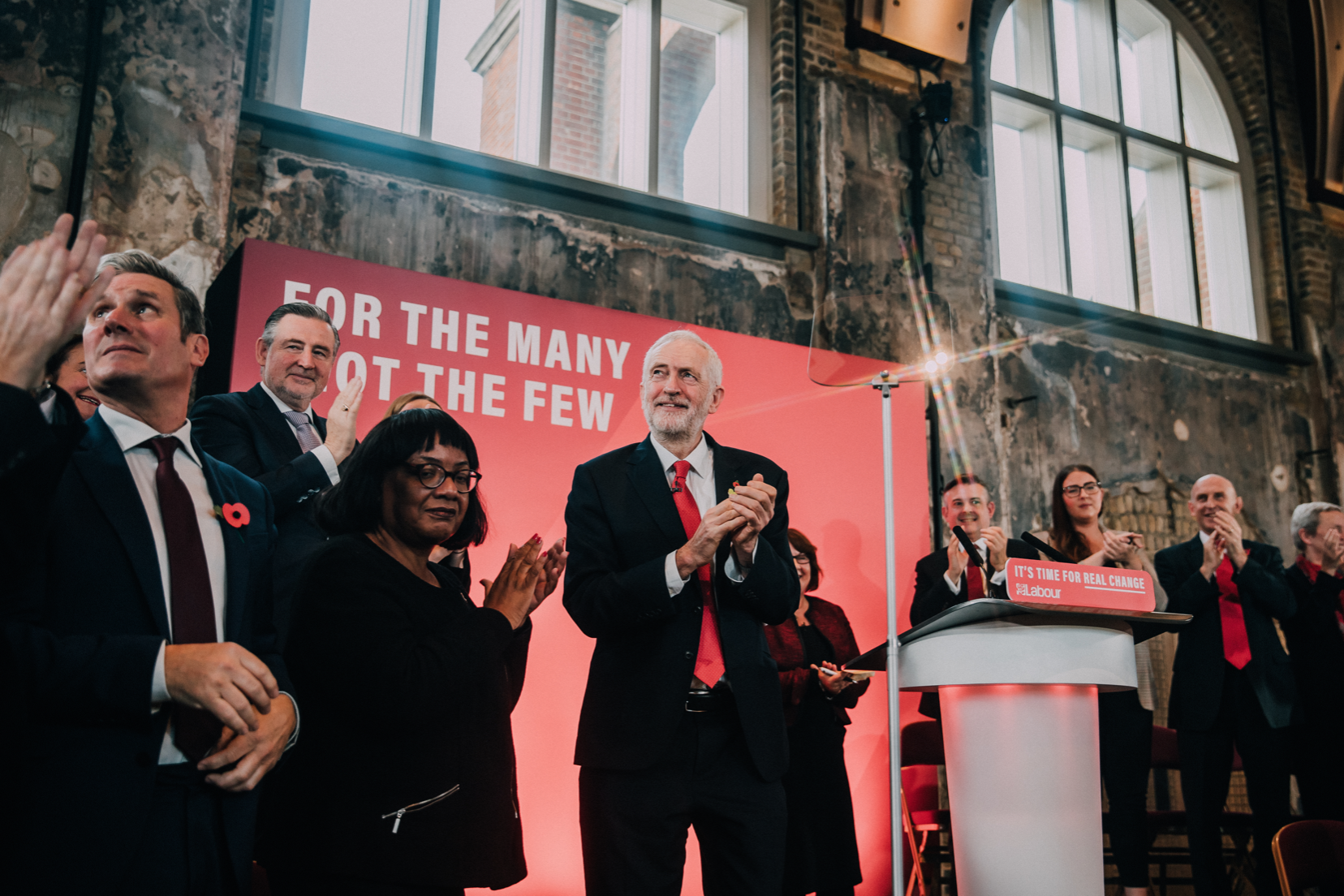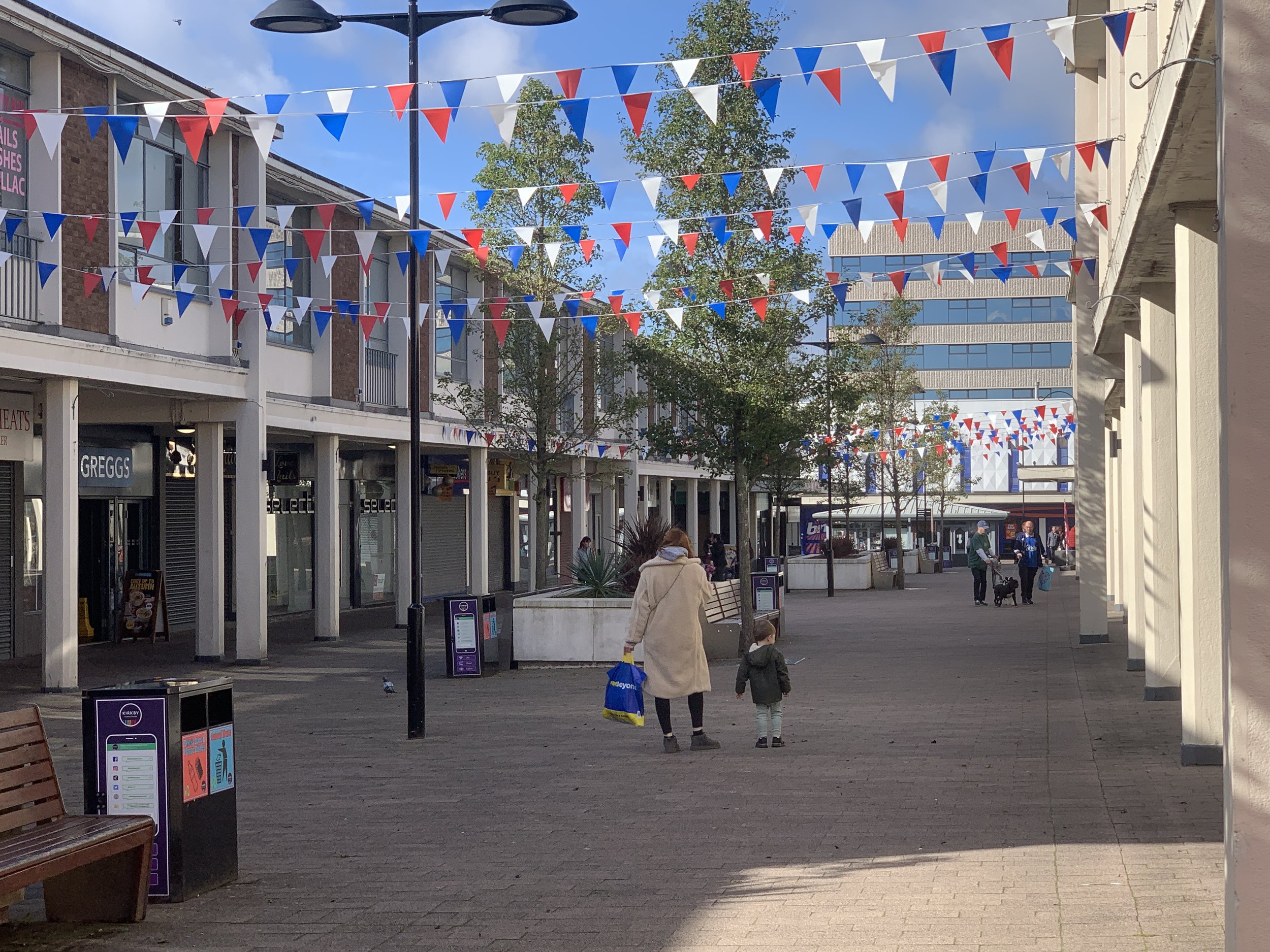Recent features
Genghis Khan, Kirkby Market and me
Since the 1990s, the town of Kirkby, a suburb of Liverpool has undergone a continuous cycle of demolition and reconstruction. The changes, though well intentioned, have largely failed to address Kirkby's social problems or arrest the high rates of deprivation. Regeneration expert, John P. Houghton, who was raised in the town, recounts Kirkby's regeneration history and argues that the social cost of change has often not been worth the price.
John P. Houghton
From rural village to manufacturing powerhouse to struggling suburban overspill, Kirkby has had a chequered history. Just 6 miles from Liverpool, in the borough of Knowsley, the town was once the inspiration for the TV show Z-Cars, a police procedural majoring on social realism in gritty estates.
In recent years, Kirkby has seen some degree of investment, from new housing and schools to a brand new market and health centre, and it recently acquired a new train station. Artwork is layered around the town’s centre including winged chairs and a wise, old elephant riding a Viking longboat. But the picture remains mixed. Hope for better rubs shoulders with as yet unfulfilled promises, marked by peeling hoardings and discarded shopping trolleys. The one thing you can say for sure is that Kirkby is increasingly unrecognisable, with planners consistently favouring demolition and rebuild over subtler forms of intervention.
One man who would know is John P. Houghton, a regeneration expert who grew up in the town. In this article, he argues that the hard lessons from Kirkby’s past need to be applied to its future - that people should come before property. John believes keeping communities together and repairing the social fabric is better than constantly demolishing and rebuilding estates…
In the year 1218, the Shah of Khwarezmia made one of the worst decisions in all of human history; he picked a fight with Genghis Khan.
The Mongol leader had made a tentative peace-with-trade offer to the Shah, the ruler of a vast Central Asian empire, by sending a caravan of ambassadors to negotiate an agreement that would allow both medieval superpowers to co-exist. In response, the Shah killed the emissaries. Khan was so enraged by this act of provocation, he immediately declared war on the Khwarezmian empire and its unwise leader. Victory on the battlefield was swift, although the Shah himself escaped and fled.
Without his enemy’s body for proof of his conquest, Khan ordered his men to the Shah’s hometown, where they demolished and dismantled every single building until no structure was left standing. Even this was not enough to satisfy Khan’s desire for retribution.
His troops went on to re-direct a local river through the place where the town once stood, washing away the last stumps of human settlement and wiping the Shah’s birthplace from the map.
While the course of Merseyside’s River Alt is probably safe, I sometimes wonder if I’ve done anything to provoke similar wrath from the planning department that oversees my hometown of Kirkby in Knowsley. Let’s look at the historical record.
Here’s a list of the now-demolished buildings that played an important part in my early life: the estate where I was born and lived to the age of four; my infant school; my junior school; my secondary school; the church where I took my first Holy Communion; the swimming baths where I dived for rubberised bricks in my pyjamas; the sports centre with its infamous ski slope; the library; he college where I did my first work experience on the local newspaper; and the ‘Mercer Heights’ tower block where my uncle lived which offered views all the way to the Mersey.
One of the few buildings from my childhood still left standing is the house where I lived until I left for university at the age of 18. But don’t get your hopes up; this is not a pinprick of light amongst the darkness. The place I called home will make an unhappy appearance later in this story.
Tales of bloody vengeance aside, there is perhaps another explanation why my hometown has been involved in this seemingly endless cycle of estate clearance and re-construction. It’s an explanation that exposes the folly of putting property before people.
To understand that story, we need to take a look at the history of Kirkby.
Kirkby has seen investment in recent years but vast tracks of land are still hidden behind ageing hoardings. A local resident complained about ‘broken promises’ over a new cinema. Image: Liverpolitan
Over-spill
In 1951, Kirkby was a village of 3,000 people on the eastern fringe of Liverpool. Nearby, the government had built the Royal Ordnance factory to supply munitions to British troops during World War II. This had seen an influx of 20,000 temporary workers during those war years but the village itself had remained largely unchanged, with its rural economy sustained by the fertile soil of the surrounding farmland. But all of that was about to change utterly and at phenomenal speed. In the years that followed, Kirkby would grow at a pace barely seen in England since the Industrial Revolution.
The transformation was driven by the UK’s post-1945 approach to urban and economic development. As in other places such as Coventry and Plymouth, vast tracts of Liverpool had been destroyed or heavily damaged by the German Luftwaffe. For urban planners facing the challenge of rehousing both industry and tens of thousands of workers this opened up untold opportunities to realise their utopian civic dreams.
Post-war government policy subsidised clean-sweep demolition and the dispersal of populations out of cramped, bomb-ravaged city centres and into gleaming, structured ‘new towns’. Kirkby, with its ample land, brief flirtation with mass production and proximity to the city, was viewed as a prime spot to begin construction.
“The people who created Kirkby could build houses, but chronically undervalued the importance of ‘third places’, where people of all ages can rest, relax and play.”
Southdene was the first estate to be built in the new town in 1952, and was followed by many, many more. Although, as we’ll see, it took longer to deliver social and cultural amenities than it did new houses; the first shops were not opened until 1955, while the first pub only began serving in 1959. Kirkby Market started trading a year later.
By 1961, the population had rocketed from 3,000 a decade earlier to 52,000; a seventeen-fold increase in ten years. My grandparents, as children, were part of this vast wave of managed migration. Young families were attracted not only by the prospect of a home with a garden, but good chances of employment too. Liverpool City Council had bought the old Royal Ordnance site and working with factory owners and manufacturers had redeveloped it as Kirkby Industrial Estate. The future looked rosy.
However, the immediate problem on “Merseyside’s largest over-spill estate” was the absence of social infrastructure or, in simpler terms, the lack of anything to do outside of the house. Especially for the huge numbers of young people who lived there.
Tower blocks like Mercer Heights have been disappearing for years. But the new housing has merit if not the same great views. It will, however, take time to build back a lost sense of community. Image: Liverpolitan
“For building’s sake”
By the early 1960s, virtually half (48%) of the Kirkby population was aged under 15. The average for England was just over a quarter (27%). If you find buses or trains quite noisy when half the passengers are school kids, imagine an entire town like that. All of the time, with practically nothing for them to do.
Demographic imbalances are understandable in the post-war context. After all, around 880,000 British soldiers, or 6% of the nation’s adult male population, had shed blood on the battlefield in WW1. Another 384,000 died in WW2.
Less comprehensible is the failure to anticipate the consequences of concentrating thousands of families in a new town without support structures or social amenities. In his blog piece, New Jerusalem Goes Wrong, John Boughton cites a 1965 article in The Times: “no-one has yet built a cinema or dance hall and, possibly for this kind of reason, the 13 and 14-year old are the town’s most frequent law-breakers.”
On the same theme, one resident complained of the local council that “all they’ve built for is building’s sake but not to take the children into consideration. Have a look around here, where on earth can children play?” The people who created Kirkby new town could build houses, but chronically undervalued the importance of ‘third places’; spaces outside the home and workplace where people of all ages can rest, relax and play.
Even reforms to how the town was governed failed to deliver a change in thinking. The Kirkby Urban District, which had been established in 1958, was abolished in 1974 and merged with nearby authorities to form the Metropolitan Borough of Knowsley.
The new structure delivered the same old emphasis on volume housebuilding at the expense of essential infrastructure. Perhaps the new authority’s ambitions were thwarted by an infamous episode in Kirkby’s history.
Sloping off
The new Borough council may have been put off the idea of building anything other than houses by the experience of trying to instal a ski slope in the grounds of Kirkby sports centre. This is one of the oddest, and still most mysterious examples of urban misadventure in England’s post-war history.
The idea, first formulated in a smoky pub in 1973, was to offer residents the chance to get some exercise by emulating the professionals on the BBC’s popular winter sports show, Ski Sunday. In reality, neither the planners nor the contractors knew how to build a ski slope in a built-up urban environment. This most basic fact may have been exposed if the building contract had been put out for open and competitive tender. However, due process was almost completely ignored as deals were done over lunchtime drinks.
“An internal inquiry at the council, found that the [ski] slope had been built “without planning permission, over a water main, on land the council didn’t own. Due process was almost completely ignored as deals were done over lunchtime drinks.”
Costs spiralled as, during safety trials, both people and parts of the slope kept falling off. This required the addition of boundary fencing and frenzied attempts to ‘de-bump’ the surface; all to no avail.
The bumps may have been caused by the “haphazard collection of builders’ rubble” used to make the mound, according to a jaw-dropping BBC Nationwide investigation. This prompted an internal inquiry at the council, which found that the slope had been built “without planning permission, over a water main, on land the council didn’t own.”
The worst allegation was that the slope had been built the wrong way around, threatening to send terrified skiers into the path of oncoming traffic on the M57 motorway. Amid howls of derision, and before it was completed, the council stopped further construction in 1975 and, you guessed it, knocked it down.
Unlike the Kirkby skiers, the local economy was initially heading in the right direction. The teenagers may have been bored, but the adults were kept busy. With a new workforce and modern factory plants, the early years of the town were an economic success story. By 1967, Kirkby Industrial Estate supported a mammoth 25,000 jobs. After the youthful exuberance of the 1960s, however, came the strife of the 1970s and 1980s.
Art designed to lift the spirits has been widely used around Kirkby. Some pieces are more successful than others. It’s unlikely the shopping trolleys were deemed worthy of a public commission, but their presence still speaks powerfully and artistically. Image: Liverpolitan
Demolition and depopulation
In 1971, the Ford factory at Halewood, south Liverpool, where my dad worked on the assembly line, laid off 1,000 workers in the middle of a strike over pay and conditions. Many more redundancies followed as factories were shuttered and workforces shrank in the face of competition and technological advancement. This included factories in Kirkby such as Thorn Electrical, which closed with the loss of 600 jobs.
By 1981 almost a quarter (22.6%) of Liverpool’s working-age population was unemployed. For the rest of that decade, and into the 1990s, Kirkby was trapped in a self-reinforcing cycle of job loss and population decline. The residents of the new town had been promised a New Jerusalem. In reality, as one Liverpool Echo report succinctly summarised, they were “let down by central government planners, corrupt councillors and the private sector alike”.
The loss of jobs and households was exacerbated by the council’s decision to use demolition as a primary response to neighbourhood decline. The BBC paid another visit to Kirkby in 1982, to report on the demolition of a large estate in Tower Hill.
As the newsreader Jan Leeming explained, the development had been built “only twelve years ago” but, according to the council, had proven unpopular and stood completely empty for the last two of those years.
As the estate is dynamited, the camera's unforgiving lens focuses on the destruction and the reporter reveals an equally devastating fact. The council will continue paying for the development for another forty years.
There was, no doubt, a case for demolishing the most unpopular and poorly-built developments, but in Kirkby, as elsewhere, widespread demolition became a self-perpetuating cycle; damaging the environment, breaking up communities, and effectively admitting failure in the task of making a decent place for people to live.
Demolishing entire estates also entailed the destruction of social and community facilities like shops, youth clubs, GP surgeries, and play areas that were already in short supply. In contrast, as a 2010 LSE research paper by Anne Power explains, refurbishment “offers clear advantages in time, cost, community impact, prevention of building sprawl, reuse of existing infrastructure and protection of existing communities.”
“In Kirkby, widespread demolition became a self-perpetuating cycle; damaging the environment, breaking up communities, and effectively admitting failure in the task of making a decent place for people to live.”
By the 1990s, central government policy became more sophisticated. The post-war policy of clearance and construction was falling out of favour. There was growing interest in the idea of comprehensive or ‘holistic’ renewal that paid as much attention to social infrastructure and public services as to bricks and mortar.
Down the road from Kirkby, the revitalisation of the Eldonian Village in North Liverpool won the prestigious World Habitat Award for its model of comprehensive, community-based regeneration. A core element of the approach was to keep the existing community together by repairing and improving the physical and social fabric.
A little further away, Urban Splash made its name in Greater Manchester by purchasing properties and as one president of RIBA wrote, “instead of demolishing them as others would have, they turned them into cool lofts and workplaces”.
Meanwhile, Knowsley council continued demolishing housing stock in Kirkby, including maisonettes and high-rise tower blocks, like Mercer Heights. While clearance and construction in other parts of the country were falling out of favour as a model of regeneration, closer to home it was still being used to spur short-term job creation.
“Driven by debt and speculation”
By 2001, Kirkby was home to just over 40,000 people, its total population continuing to slide down from its 60,000 peak in the economic heyday of 1971. I was part of that outflow, leaving for university in 1996 and returning only ever temporarily to spend time with my family.
In 2011, on one such visit, I drove past my old house, the one mentioned earlier, where I’d spent the majority of my childhood years. I was shocked to find that it was not only empty, but vandalised and partially burned out. I wrote about the situation at the time and it was picked up by Aditya Chakrabortty for The Guardian.
Home sweet home, but not as John remembered it. Time can be cruel. Image: John P. Houghton
The crash of 2008 and the harsh recession that followed had exposed the danger of relying on a fundamentally unstable and over-inflated housing market to drive economic growth. In effect, Knowsley Council, like others, had used housebuilding as a short-term economic stimulant.
When an area declined, clean-sweep clearance and new home construction was used to create jobs and generate economic activity in the immediate supply chain. But these gains were only ever short-term. When you factor in the disruptive social impact of this approach the cycle of knocking down and rebuilding ultimately becomes damaging and self-defeating.
This wasn’t building to make a community, but boosterism to stimulate a brief burst of economic activity in the absence of anything more sustainable or useful. As Chakrabortty put it, “places such as Kirkby remind us that what’s collapsed isn’t [just the economies of] a handful of countries, but an entire model of economic development: one driven by debt and speculation, which ignored the need for productive industry.”
“Kirkby reverses its fortunes”
Kirkby’s prospects for the next few decades are brighter than they have been for a while. After the re-opening of Kirkby Market, the Financial Times in 2022 described private sector investment as “driving a retail revival in a deprived northern town.”
The Liverpool Echo came to a similar conclusion, citing data showing Knowsley “experiencing one of the strongest post-pandemic recoveries throughout the UK when it comes to local spending”. The council is exploring the idea of ‘community wealth building’ as a way to keep more of the money spent locally circulating within the borough’s economy.
The re-opening of the market was part of the long-running redevelopment of the town centre, which in turn is one of several investments in the town. A new train station, Headbolt Lane, opened in October 2023, connecting the Northwood neighbourhood to the line that runs straight into the centre of Liverpool.
If this recovery is to be sustained, the hard lessons learned from Kirkby’s past need to be applied to its future.
The profound social and economic costs of constant clearance and construction massively outweigh the short-term gains of using housebuilding to boost the local economy. Instead of widespread demolition and scattergun population dispersal, we should learn from projects that repair the social and physical fabric.
Neighbourhoods need more than just homes. They need pubs and parks, creches and community centres, libraries and lidos. Places that nurture a sense of community and give people the best environment to have a decent crack at life.
To ignore these lessons would be a folly worthy of the Shah of Khwarezmia.
Kirkby High Street on a sleepy Sunday. Images: Liverpolitan
John P. Houghton is a freelance consultant who works with councils, developers, housing associations, and community groups to make better places. A specialist in urban regeneration and economic development, John has advised the UK government on large-scale institutional investment in major projects. He was born and raised in Kirkby.
John regularly posts articles on his blog, Metlines in which an earlier version of this feature appeared. He can also be found on X (formerly Twitter) @metlines.
What do you think? Let us know.
Add a comment below, join the debate via Twitter or Facebook or drop us a line at team@liverpolitan.co.uk
Not So Red: Labour’s Slow Rise in the Scouse Republic
Liverpool wasn't always the ultimate Labour stronghold. For much of the past century, Conservatives have dominated local and parliamentary elections. Historian of the Left, David Swift, charts Labour's surprisingly slow rise to power in not-so-red Liverpool.
David Swift
You don’t often see Liverpool compared to Iran. And certainly a stroll through the city centre on a Friday or Saturday night brings sights you probably wouldn’t see in downtown Tehran.
In an essay comparing the politics of Iran and Egypt, the sociologist Asef Bayat pointed out that Egypt, despite having strong popular support for Islamist politics and a weak middle class, never established a religious theocracy along Iranian lines. The difference being that in Iran, the government of the Shah had successfully eliminated all secular opposition – liberals, socialists, trade unionists – so the Mullahs were the only people in a position to take over, despite a lack of broader support for their project. So Egypt had an Islamic movement but not an Islamic revolution, and Iran had an Islamic revolution without much of an Islamist movement.
Over the past 100 years something similar has happened in the political transformation of Liverpool. From a bastion of working-class Toryism, Liverpool has become a city with the five safest Labour seats in the country. Other areas with similar demographics have seen Labour’s support slide in recent years, but in Liverpool the party’s dominance has continued to grow.
Yet curiously, beneath the surface, just like in Iran, the dominant political movement has been anything but strong. Liverpool has undergone this Labour revolution with a much weaker, organised Labour movement than other cities. Don’t believe me? Look at the history.
This year marks the centenary of the election of Jack Hayes, the first Labour MP to sit for a Liverpool constituency – who won the 1923 Edge Hill by-election. This breakthrough came roughly two decades after other ‘Labour heartlands’ such as Manchester, East London, Glasgow, Leeds and South Wales had elected their first Labour MPs.
Before and even after Jack Hayes’ triumph, Liverpool was solidly Tory. From 1885 to 1923, with just a few exceptions, the city’s nine constituencies were won by the Conservative candidate in every parliamentary election. Toxteth was represented by people with little claim to working class roots; people with grand-sounding names such as Henry de Worms and Augustus Frederick Warr. It is hard to imagine now but for 14 years the MP for rugged Kirkdale was a Baronet called Sir John de Fonblanque Pennefather.
The most notable exception to Tory dominance at that time was the Liverpool Scotland constituency, centred on Scotland Road, which was dominated by Irish immigrants. Held by the Irish Nationalist T.P. O’Connor from 1885 until his death in 1929, his victory remains the only time a British parliamentary seat has been won by an Irish nationalist party outside the island of Ireland.
Of course, the Liberals had the occasional reason to celebrate too, winning Liverpool Exchange in 1886, 1887, 1906 and 1910 as well as Liverpool Abercromby in their general election landslide of 1906. But even at that election – a wipeout for the Tories and their worst result until 1945 – the Liberal Party only managed to win two of Liverpool’s nine seats, with the Conservatives taking six out of the other seven.
An Irish Republican, Tory Baron and Liverpool’s first Labour MP walk into a bar. But who’s who?
Left to Right: Jack Hayes Labour MP for Edge Hill (1923-31); T.P. O’Connor the Irish Nationalist MP For Liverpool Scotland (1885-1929); and Baron Henry de Worms, Conservative MP for East Toxteth (1885-95). Image credits in respective order (left to right): Bassano Ltd, public domain via Wikimedia Commons; Bain - Library of Congress (1917); Alamy
Some commentators have claimed Liverpool politics are based on rebelliousness or innate defiance and a willingness to speak up and go against the crowd. Which makes what happened in the 1906 general election all the more fascinating. Dominated by the issue of free trade, the Conservatives lost badly at the national level because it was feared their plan to impose tariffs on imported goods would damage trade. And yet even in this election, in a town as totally dependent on trade as Liverpool, even in a port city, Liverpolitans put two fingers up to the national trend and voted for the Tories anyway. Was this an early example of that noted tendency to contrarian defiance or slavish support for the party of power?
Of course, at this time, the six-year-old Labour party was not a serious force around the banks of the Mersey and their leader Ramsay MacDonald – who later become the first Labour Prime Minister, knew it too. In 1910, after a visit to the city he seemed to accept they had no prospects of winning there any time soon, writing with a note of sour grapes that ‘Liverpool is rotten and we had better recognize it’.
Why was Liverpool so slow to support the party of the working class?
One explanation often put forward is the narrowness of the parliamentary franchise which dictated who got to vote. It’s claimed voting restrictions prevented many working people from making their voices heard and it’s certainly true that this affected politics at this time, though perhaps not always in the ways most commonly understood. From 1867, men in ‘borough’ constituencies (usually towns and cities like Liverpool) were able to vote in general elections but only if they were defined as a ‘householder’. This meant a man living independently by himself or with his wife and children who also paid a minimum of £10 a year in rent. In theory, most working-class men could now vote, but in reality it’s estimated 40% of men nationwide were disenfranchised until these rules were relaxed in 1918.
This was because the lack of affordable accommodation meant many men still lived at home with their parents or in houses with multiple families, and so fell foul of the rule. In a port city like Liverpool, where seafaring was the second largest source of employment, this would have been particularly significant because so many men worked away for long periods. The 1921 census found there were twelve times as many men without a fixed address or workplace in Bootle than in St Helens.
Nonetheless, some historians have challenged the idea the franchise disproportionately affected working-class voters, noting that, on average, men from working-class backgrounds found work, left home and started families earlier than their middle-class equivalents. As noted by Neal Blewett in an article for Past and Present, middle-class professionals were more likely to be lodgers, who very often couldn’t vote. It’s too easy to use the disenfranchisement of working-class voters to explain Tory dominance in the city - especially since women, who have tended to favour the Conservatives by wide margins, were unable to vote in general elections until 1918. Perhaps the limitations on the voting franchise hurt rather than helped the Tories. In her influential book, The Iron Ladies (1987), journalist Beatrix Campbell claimed Labour would have won every election between 1945 and 1979 but for women’s right to vote.
The influence of sectarianism overstated
It’s also too easy to blame ‘sectarianism’ for Tory rule in Liverpool. According to this analysis, conflict between Protestants and Catholics divided the working class vote, with Catholics favouring ‘home rule’ for Ireland supporting the Irish Nationalist party (the IPP), while Protestants opposing greater Irish autonomy voted for the Conservatives. The argument goes that the conditions for a Labour breakthrough in Liverpool only occurred after Irish independence in 1922, when the sting went out of the nationalist cause. Catholic votes transferred to Labour, whilst Protestants, with the nationalist issue seemingly resolved, felt less inclined to vote Tory.
But many historians, such as Sam Davies, have downplayed the importance of sectarianism, arguing instead that Tory dominance resulted from the weakness of the Labour party in local politics and splits in the anti-Tory vote.
Famously, Churchill sent gunboats on the Mersey in 1911 to quell a dockers strike, but despite this Liverpool was still voting Conservative. Meanwhile in Glasgow … Red Clydeside was already represented in parliament. Image: HMS Antrim, Ernest Hopkins, Public domain, via Wikimedia Commons
It’s instructive to compare the political situation in Liverpool to that of Glasgow - another town with a violent sectarian divide. While Liverpool outside of Scotland Road was staunchly Tory, in Glasgow, sectarian sentiment saw a surge in support for the Liberal Party. As far back as 1886, with the Liberal Government led by William Gladstone (a Liverpolitan), proposing Home Rule for Ireland under a less centralised United Kingdom, Catholic voters jumped at the opportunity to get behind the Bill. Nationally, the 1886 general election saw the Liberals lose over 150 seats as the issue proved unpopular. Yet in Glasgow, the Liberals won four of the city’s nine seats – with another two going to the ‘Liberal Unionists’ who, opposing the move, were no doubt supported by the city’s Protestants. Liverpool never saw anything like this degree of sectarian influence.
Back to that 1906 election, which by the way was only the second to be contested by the newly-formed Labour party. While Liverpool was busy voting Tory, in Glasgow, former shipyard worker George Barnes was elected as a Labour MP for Glasgow Blackfriars and Hutchesontown, a seat he held until he was elected for the new Gorbals constituency in 1918, alongside Neil Maclean, who won in Govan. By 1922, Labour was winning ten of the city’s 15 seats. In contrast, no Liverpool constituency elected a Labour MP until after the party had taken most of the seats in Glasgow.
“It is perhaps forgotten today, but back in the interwar years, the largest unions on Merseyside, the TGWU and the National Union of Seamen - representing dockers and sailors – had an inconsistent relationship with the Labour party.”
The importance of skilled workers and Nonconformists
One reason for Labour’s earlier breakthrough in Glasgow was its stronger concentration of skilled trades. Although like Liverpool, a major port, Glasgow relied less on distribution and more on the dominant industry of shipbuilding. This provided a stronger industrial base with many skilled jobs defended by well-organised trade unions. Even if we include the Cammel Laird shipyards in nearby Birkenhead, Liverpool never had a similar level of manufacturing jobs. There was far too much reliance on low-skilled, casual labour which was a lower priority for the wider trade union movement.
At this time, areas that voted Labour had either strong trade unions, or high levels of Nonconformist Protestants such as Baptists, Methodists, Quakers – or both. You can see this trend in places like South Wales, West Yorkshire, East Lancashire, and the Durham coalfield. Nonconformity was linked with moral and political liberalism: Nonconformists such as William Wilberforce had been prominent anti-slavery advocates, and were over-represented among critics of British imperialism. They also challenged elements of the British establishment such as the Church of England and the House of Lords. In Liverpool, however, the trade unions were small or weak, whilst most people were Catholics or Anglicans, with few Protestant Nonconformists.
It is perhaps forgotten today, but back in the interwar years, the largest unions on Merseyside, the TGWU and the National Union of Seamen - representing dockers and sailors – had an inconsistent relationship with the Labour party. In 1927, the Executive Committee of the Liverpool Labour Party (then known as the Liverpool Trades Council and Labour Party) was formed from clerks, postal workers, electricians, engineers, railwaymen, painters and insurance workers. Dressmakers, shop assistants, clerical workers, tailors and garment workers were all well represented in the membership – but representatives from the two dominant occupations in the city were conspicuous by their absence.
Tories still strong after World War 2 and the politics of normal
Even after the 1945 Labour landslide, the Conservatives continued to win elections in Liverpool. Tory MPs were elected for Walton and West Derby until 1964, and for Wavertree and Garston until 1983. At the 1959 local elections, six of Liverpool’s nine council wards were controlled by the Conservatives, and three of those were solidly working-class areas, including Toxteth and Walton.
During the 1970s, control of the council swung between the Tories and Liberals. When the Trotskyist Militant Tendency took over in 1983, they succeeded a Conservative-Liberal coalition.
When Labour was successful on Merseyside in this period it was not because of a strong local labour movement, but because political sentiment was tracking with the ‘normal’, with the city tending to vote in line with national trends
Speaking to political scientist David Jeffery, who studies electoral politics in Liverpool, he told me that after the Second World War there was a general trend towards the ‘nationalisation of politics’. By this he means that national rather than local issues became key determinants in deciding how to vote. Local politics began to matter a lot less, so the Liverpool vote tracked the national vote share. As elsewhere in the country, the party in power nationally would usually suffer in local elections.
As Jeffery explained, the Tory successes in council elections during the late 1960s were not driven by a surge in support for the Tories, but rather a collapse in the Labour vote due to the growing unpopularity of Harold Wilson’s Labour government in Westminster.
Then in the early 1970s, when Ted Heath’s Conservative government was unpopular, Labour and the Liberals did better in local elections, and in 1998, a year after Tony Blair’s Labour landslide, the Liberal Democrats once again took power of Liverpool City Council.
Prone to takeover – the problem with Labour’s low local membership
Even though there was a real change of the political culture and identity of the city in the 1980s, there was still not much of a labour ‘movement’. One of the reasons Militant was able to take over Liverpool Labour was because the local Labour party branches had relatively few members. They’d become hollowed out and simply didn’t have enough people to buttress against a well-organised and well-motivated sect.
Historically, in areas without strong trade unions there would be relatively few people in the local Labour party – put simply if you were not a union member or close to a union member you were far less likely to get involved with Labour. So once the unions lost their strength and influence from the 1980s onwards, alongside a decline in local government, the traditional working class routes into local politics dried up. Membership of Labour constituency branches (CLPs) in traditional working class areas has been on the slide ever since. As an example, the biggest constituency Labour parties today such as Hornsey and Wood Green in London have over 3,000 members, but one of Liverpool’s largest, Liverpool Walton, claims to have just over one thousand, and that might have been at the height of the Jeremy Corbyn membership surge.
One of the reasons Militant was able to take over Liverpool Labour was because the local Labour party branches had relatively few members. They’d become hollowed out and simply didn’t have enough people to buttress against a well-organised and well-motivated sect.
Just as in the early twentieth century, Liverpool today has a large working-class population, but it doesn’t have much of a labour movement – despite Labour consistently winning elections.
There have been well-supported social justice movements: such as during the dock strike of 1995-1998, the Hillsborough Justice Campaign, and more recently grassroots initiatives such as Fans Supporting Foodbanks. But this hasn’t translated into high membership or engagement with the Labour party itself.
Middle-class activists and the politics of identity
Labour’s membership surged under the leadership of Jeremy Corbyn from just 198,000 in 2015 to 564,000 by 2017. But how many of these new members were from traditionally working class communities? Creative Commons C.C.0 1.0 via Wikimedia.
As far back as Tony Blair, commentators have noted how the ‘Islington set’ have become increasingly influential in the politics of the Labour party. People whose personal circumstances had taken them a long way from the traditional Labour voter were now shaping the party’s direction. During Jeremy Corbyn’s leadership in the 2010s, membership of the party grew, but often those new members were not from the traditional voter base. London, by comparison to Liverpool, has far higher levels of middle-class graduates and these are exactly the kind of people who have historically joined political parties. It’s not surprising that in places with more middle class voters, there’s been increased enthusiasm and engagement with Labour. But back in the Labour heartlands, not so much. This relative lack of enthusiasm and political engagement can be seen by comparing the turnouts of the last mayoral races in Liverpool and London: in both cases, everyone knew that the Labour candidate would win, yet in London the turnout was 40%, in Liverpool it barely reached 30%.
In recent years, the Liverpool Left has become more radical on cultural issues such as race and ethnicity - but it’s doubtful whether the city’s population is as liberal as their representatives on these issues.
The website, Electoral Calculus breaks down the demographics and political culture of each of the UK’s 650 constituencies, and ranks them according to their political opinion on economics (Left versus Right), internationalism (Global versus National) and culture (Liberal versus Conservative). It then uses cluster analysis to identify the influence of one of seven ‘Tribes’ in each constituency - including ‘Progressives’, ‘Traditionalists’, ‘Centrists’, ‘Kind Young Capitalists’, ‘Somewheres’, ‘Strong Left’ and ‘Strong Right’. It also estimates how each constituency seat voted in the Brexit referendum, a much finer grain of breakdown than exists in the official statistics.
Let’s take a look at how it assesses Liverpool’s five safest Labour seats:
Liverpool Walton - Traditionalist
27 degrees Left, 3 degrees Globalist and 1 degree Conservative; 52% voted Leave.
Knowsley - Traditionalist
26 degrees Left, 2 degrees Globalist, 2 degrees Conservative; 52% voted Leave.
Bootle - Traditionalist
25 degrees Left, 3 degrees Globalist, 0 degrees Social; 50% voted Leave.
West Derby - Traditionalist
26 degrees Left , 6 degrees Global, 1 degree Liberal; 48% voted Leave.
Liverpool Riverside – Strong Left
21 degrees Left, 29 degrees Globalist and 18 degrees Liberal; 27% voted Leave.
As you can see, the top four constituencies are classed as ‘Traditionalists’, according to the Electoral Calculus formula. The people in these seats have, on average, left-wing economic views but cultural and social views that are centrist or conservative.
Traditionalist Kirkby. Small ‘c’ conservatism may rule when it comes to social and cultural views in many of the region’s Labour constituencies. Image Kirkby High Street (2023) by Paul Bryan
In a recent study into how local identities impact on voting behaviour in the Liverpool City Region, David Jeffery also found that while Liverpool constituencies are in the bottom quarter nationally in terms of pro-monarchy sentiment, they are still more pro than anti-monarchy. He found that only 18% of Liverpudlians feel ‘only Scouse’, just 5 percentage points higher than the 13% who feel ‘only English’, with the rest feeling some mixture of Scouse and English.
What can we read into this?
It appears that despite the victories of the Labour party in parliamentary and local elections, there is a large amount of small ‘c’ socially conservative sentiment in the city. That is why up to three constituencies likely voted Leave, and why UKIP came third in the 2014 local elections – only 969 votes off the Greens in second place. They did especially well in working-class wards such as Club Moor, County, Fazakerley, and Norris Green.
This data suggests there’s a risk of Liverpool Labour overreaching on culture, as happened recently with the Scottish National Party (SNP). Despite Scotland’s population being slightly more sceptical on trans rights than the UK average, the SNP leadership assumed they could push forward with radical gender policies - an approach which led to Kate Forbes, who opposes same-sex marriage, coming within 3,000 votes of winning the party’s leadership election.
Within the past year, the SNP has gone from looking invulnerable to now polling only 1% ahead of Labour. Obviously this has not all been down to overplaying their hand on cultural issues, but nonetheless it’s a salutary warning for Liverpool Labour about the dangers of hubris, and mistaking the transformation in the politics of the city for a transformation in its culture.
In the hundred years since the election of the city’s first Labour MP, Liverpool’s support for Labour appears stronger than ever. But history suggests an unpopular Starmer government and continued chaos at the municipal level could well see the party lose power locally and for the majorities of the city’s MPs to be chipped away. The city’s current loyalty to Labour cannot be taken for granted, either by national politicians looking to Liverpool for lessons, or by local figures who might mistake voting patterns for political and cultural radicalism.
David Swift is a historian and writer specialising in Left wing activism who has written for publications such as the New Statesman, The Times, Tribune and Unherd. He is the author of three books including A Left For Itself; and The Identity Myth.
His latest book, Scouse Republic? A Personal History of Liverpool, will be published in 2024 by the Little, Brown Book Group.
*Main image created on Stable Diffusion.
Remembering Capel Celyn
In 1965, the Welsh village of Capel Celyn was flooded to supply fresh water to Liverpool. It’s been a sore point ever since, provoking Welsh nationalist sentiment and an official apology from Liverpool City Council forty years later. Looking back, was this simply a case of predatory exploitation or can an argument be made that it was a rational decision based on the needs of the majority?
John P. Houghton
Trinity Mirror / Mirrorpix / Alamy Stock Photo
In 1965, a Welsh village was flooded to supply fresh water to Liverpool. It’s been a sore point ever since, provoking Welsh nationalist sentiment and an official apology from Liverpool City Council forty years later. Looking back, was this simply a case of predatory exploitation or can an argument be made that it was a rational decision based on the needs of the many?
Described by the BBC as “an idyllic Snowdonia village”, Capel Celyn in the Tryweryn Valley, North Wales was a quiet, rural settlement, home to 67 people, a general store, a post office, a cemetery, a school, and the Methodist chapel after which it was named. Reliant on the surrounding farmland for jobs, bucolic Capel Celyn seemed a world away from the kind of UK envisaged by the British Prime Minister, Harold Wilson when he announced his plan to transform these isles by unleashing the white heat of a new scientific revolution.
Pobol y Cwm / People of the Valley
According to Prof. Ed Atkins of the University of Bristol School of Geographical Sciences, the village typified a “certain type of Welshness” that was deeply connected to the landscape and, in a country losing its linguistic heritage, still predominantly Welsh-speaking. Liz Saville Roberts, the current MP for Dwyfor Meirionnydd described the inhabitants as an integral part of “one of the richest folk cultures in Europe”.
Yet for all its traditional, rural qualities, the village was actually moving into the modern, post-war world. Some of the villagers had radios and TVs and more were on the electricity grid. Capel Celyn was a living, breathing, working community. It was not a moribund settlement in terminal decline. And yet, I describe Capel Celyn in the past tense because, in 1965, the village and surrounding farmlands were deliberately flooded. Despite a decade of organised opposition and bitter resistance, Alderman Frank Cain of the Corporation of Liverpool pulled a lever and buried the place under 68 million tonnes of water.
The stated rationale at the time was that the city had started to run out of water because its economy and people were becoming “increasingly industrialised” and thankfully due to rising hygiene standards, “increasingly sanitary”. And so to meet this need, Capel Celyn became Llyn Celyn, or to use the English, Lake Celyn. The natural terrain of the Tryweryn Valley became a man-made reservoir.
The story of Capel Celyn is barely known in England. The name only appears in the media when, as with this summer, hot weather and drought conditions reveal “haunting” images from an underwater village. ‘Underwater’ invokes the myth of Atlantis and sounds much less disturbing than “drowned” or “flooded”.
In Wales, however, especially in the north, the name still resonates. In his 2017 Raymond Williams lecture, Welsh actor Michael Sheen listed the destruction of the settlement as being among the worst humiliations inflicted on the Welsh by the British in their entire history. The other national disgraces he rolled off included the construction of Edward Longshanks’ ‘Ring of Iron’ castles along the coast of North Wales to intimidate the locals into acquiescence; the brutal suppression of ironworkers opposing the lowering of their wages by British troops during the Merthyr Rising; and the quashing of the Rebecca Protests, which had seen struggling tenant farmers pushed to their financial limit by the imposition of road tolls. That’s the kind of company in which the drowning of Capel Celyn was viewed.
In this article, I’m going to look at the events running up the flooding, the resistance it provoked, and the lessons we can learn as water access and water shortages become increasingly seen as a source of conflict in a global climate emergency.
Thirst
The stated justification for the drowning of Capel Celyn was that Liverpool was running out of water for domestic and industrial use. The Corporation of Liverpool, the forerunner to the council, claimed that its existing supplies were on the brink of exhaustion. The city’s need for water, it was argued, could only be met, by “overdrawing” from existing reservoirs and “obtaining temporary bulk supplies of water from Manchester”. With the city’s industries growing and the replacement of old slums with new housing increasing the demand for clean water, the situation was, they said, one of “very considerable urgency”.
For those who argued that Liverpool needed to look beyond its current sources, the Tryweryn Valley was the obvious candidate. It was geographically close to Merseyside, was one of the largest water watershed catchment areas in Wales, and could be turned into a large reservoir with a single dam.
“Everyone deplores the fact that in the interests of progress sometimes people must suffer, but that is progress.”
Bessie Braddock, Labour MP for Liverpool Exchange
Of course, Capel Celyn was not the first, nor would it be the last, settlement to be sacrificed to meet a town or city’s demand for water. Welsh rivers had been dammed and re-directed since the 1800s. Llyn Efyrnwy (Lake Vyrnwy) was built as a reservoir in the 1880s by the Liverpool Corporation Waterworks Committee. This earlier scheme necessitated the flooding of Vyrnwy Valley and the submerging of the rural settlement of Llanwddyn. In the process, a church, two chapels, three inns, ten farmhouses, and 37 houses were dismantled.
By the 1950s, however, the context had changed. The Welsh nationalist and pro-independence movement, spearheaded by Plaid Cymru — Party of Wales, was in the ascendant. They chafed at the extent to which Welsh land and resources had been confiscated and appropriated over the centuries. By the end of World War Two, for example, fully 10% of Welsh land was owned by the Ministry of Defence, as cited by Dr Ed Atkins. It was hardly surprising then, that any new plans would meet with resistance.
The first the Capel Celyn villagers heard of the plans was in the winter of 1955 when the Welsh edition of the Liverpool Echo reported that the Corporation of Liverpool was considering flooding the valley to construct a reservoir.
However, it wasn’t until January 1957, that the Corporation held a meeting with the community in their own village. The Corporation claimed that there had been meaningful consultation, but campaigners and local authorities disputed this vehemently. They claimed that they were effectively presented with a fait accompli, which they had no power to reject or amend. As one of the scheme’s opponents in the House of Lords put it a few years later; “there were rumours… but we heard nothing more…until the complete scheme was there. I do not suggest that Liverpool is a "big bully," but that is the treatment a bully metes out.”
Various accounts suggest that in essence, officials’ contacts with villagers were not about consulting or listening. They were there to explain, in cold and technical terms, a decision that had already been made and would be enacted regardless of the villagers’ views.
Resistance
There was immediate and furious opposition to the plans.
Many were opposed on the grounds of natural justice. It was simply unfair to displace an entire community in the service of another. A more explicitly political form of opposition depicted the Corporation’s behaviour as another example of England’s colonial exploitation of Wales’ natural resources.
A pamphlet produced by Plaid Cymru stated that the decision was not driven by need but by greed; the Corporation wanted to take the water and sell it for a profit, they asserted. This point was also made by Welsh parliamentarians in the debates that, as we’ll soon see, became an integral part of this story.
The resistance on the ground took many forms. The villagers’ first act was to form the Tryweryn Defence Committee. The Committee organised an extensive letter-writing campaign, mobilising citizens across Wales, and supporters across the globe, to write to the Corporation, the Home Office, №10 Downing Street, and anyone else who might listen.
Dr Matthew Green, who covers Capel Celyn in the excellent Shadowlands: A Journey Through Lost Britain, describes the tone of the letters as “beautifully vitriolic”.
The Defence Committee organised a rally in Bala, the nearest town, and a public meeting in Cardiff, to raise awareness of the threat they faced. Captured by the local press, children from the doomed school held their own march through the village. The Committee also sent a delegation to try to speak at a meeting of the Corporation, but were heckled and eventually ejected from Liverpool Town Hall. A protest march in the city was met with similar hostility. Eurgain Prysor Jones was just three years old when she was taken on the march by her parents. As she recalls, “the reception we had in Liverpool was awful. People were spitting and throwing rotten tomatoes at us. It was an awful disappointment.”
In December 1956, Liverpool Corporation voted in favour of building the dam and flooding the valley. The Corporation, however, had no power over land in Wales. They would need the blessing of a higher power to get their way.
“That is progress”
Given the scope and scale of opposition, it would have been extremely difficult and time-consuming to go through the normal planning procedures to construct the reservoir. What Welsh politician would vote to drown a Welsh-speaking village to supply water to an English city?
The Corporation had to identify an alternative route to get the planning permission they needed to proceed. Like the water they would unleash on the village, they found a way around the obstacles in their path by working with friendly MPs from other parts of the UK to sponsor a Private Members’ Bill in parliament. This mechanism allowed individual MPs to put forward legislation, separate from the government’s legislative agenda.
The Tryweryn Reservoir Bill was presented to the House of Commons in January 1957. Passage of the bill into law would allow the Corporation of Liverpool to circumvent the Welsh planning authorities and obtain a Compulsory Purchase Order for all the land in the valley. When the motion came to a vote in July of that year, 35 of the 36 MPs representing Welsh constituencies voted against it. The 36th, the Conservative MP for Cardiff North, abstained.
“We knew our home would be gone, our chapel would be gone, our school would be gone and our friends would be moved to different parts… I think if it happened today we would have (been given) counselling for trauma.”
Eurgain Prysor Jones, resident of Capel Celyn
So what was the attitude of non-Welsh MPs? What of the Labour MPs who were, in theory at least, guided by notions of working-class solidarity across national boundaries? Bessie Braddock, the Labour MP for Liverpool Exchange, justified the decision on utilitarian grounds. “Everyone deplores the fact that in the interests of progress sometimes people must suffer, but that is progress,” she said.
The same pragmatic apologia was offered by another Liverpool MP, the Conservative Sir Victor Raikes. “If it is decided that it is in the interests of a large number of people [and] the rights of a small number of people are affected, then, subject to proper safeguards for the minority, the right of the majority must prevail,” he intoned.
Meanwhile, the Conservative MP, Henry Brooke, may have faced a conflict of loyalties. He was both the Minister for Housing and Local Government, and the Welsh Secretary. In the former role, he would no doubt support any measure to fuel the industrial resurgence of the North West. In the latter role, should he have been minded to stand up for the rights of the people of the valley? If he did have mixed feelings about the choice before him, he concealed them very well. Brooke voted for the bill. Its successful passage, on a vote of 166 to 117, left the Welsh authorities utterly impotent. and meant the Corporation of Liverpool could proceed without delay.
The villagers, their supporters and sympathisers, had petitioned, protested, and marched. They had taken their case to the Corporation of Liverpool and the House of Commons in London. Both times their pleas had fallen on ears that were not only deaf, but deliberately closed; their plight met with the sort of bureaucratic detachment and dry, etiolated language that justified their suffering in the cause of the common good.
“A darker turn”
Parliament’s decision triggered a second, more direct and aggressive wave of resistance. What else was there left to do after the inability of Welsh MPs to stop the plan had shown, as one article at the time put it, “how powerless Wales was in a political sense”?
The fight to halt the project took a darker turn. In 1962, shortly after evictions began, two men travelled from Gwent to damage heavy machinery on the site. Their fine of £50 was paid by supporters and they were greeted as heroes outside the court by Gwynfor Evans, the President of Plaid Cymru. In early 1963, with the construction of the dam well underway, three men formed Mudiad Amddiffyn Cymru — the Movement for the Defence of Wales. In their first direct action, they planted a bomb on the building site. The explosion destroyed a transformer and earned one of the men a year in jail.
Yet the work ground on.
Ghost town
Like a prisoner on death row, the valley had to be made ready for its end. As Dr Green puts it in Shadowlands, “The Tryweryn valley was systematically scoured of buildings, trees and graves.” The houses were dismantled. Bodies in the cemetery were disinterred, with families given the grim choice of paying to have their relatives’ remains removed, or doing it themselves. The church was deconsecrated, with some of the masonry used in the construction of the dam.
The final residents were evicted in the spring of 1963.
Some villagers did reconcile themselves to a different future. Green tells the story of John and Mabel Evans who agreed to move out of their home into a larger house that came with electricity and 34 acres of land. But they were very much in the minority. Of the 67 inhabitants, 48 people refused to do a deal with the Corporation and were moved against their will.
Eurgain Prysor Jones, the young girl we met earlier when she marched through Liverpool, looked back as an adult on the emotional impact of their ousting; “It was a very unsettling time… We knew our home would be gone, our chapel would be gone, our school would be gone and our friends would be moved to different parts… I think if it happened today we would have (been given) counselling for trauma.”
In September 1964, the basin’s floodgates were closed and the river was dammed.
The scene was set.
Here comes the flood
Astonishingly, given the hurt and anger they had provoked, the Corporation of Liverpool decided to make a day of the drowning.
It was Thursday 21st October 1965. The Corporation’s 400 invited guests were met with at least the same number of protestors who, wielding placards and megaphones, barracked the VIPs as they arrived in a convoy of official cars. The subsequent events would be farcical, even comical, if the context for the day was not so tragic. The protestors cut the microphone lead, so the dignitaries’ speeches were drowned out by chants and curses. The Lord Mayor of Liverpool had to duck and weave his way through a hailstorm of insults and projectiles. As one protestor recalled, "They were driving the dignitaries from Liverpool across the dam. Each time a car went past we'd lift it off the road and rock it. We ran down to the marquee and I saw a man pick up a brick and throw it.”
The planned forty-five-minute ceremony of self-congratulation was condensed to a chaotic few minutes before Alderman Cain pulled the lever and the deed was done.
Après le déluge
We can look at the legacy of Capel Celyn in a number of ways.
In practical terms, the water from the valley did flow to Liverpool. A general argument can be made that, when building essential infrastructure, the needs of the many should come before those of the few, as long as there are robust and democratic safeguards in place.
A decade ago, some residents’ groups and businesses in East London were moved, through compulsory purchase, and despite their stiff opposition, to make way for what became the London 2012 Olympic Park. Today, advocates of the HS2 high-speed rail line might argue that the negative impact on villages along the route is justified by the claimed benefits that the route will bring to millions of people in the North. As long, of course, as there is adequate compensation and engagement.
It is hard to make this argument in relation to Capel Celyn. Compensation was offered to the villagers, but only after a decision had been taken and without meaningful consultation with the residents or their representatives. When they tried to make their voices heard, they were rejected and ignored.
Most significantly, there remains controversy to this day as to the true scale of Liverpool’s need for water. In the parliamentary debate mentioned earlier, Thomas Jones, MP for Merionethshire, argued that “Liverpool is (involved) in this adventure… for the sake of profit out of the sale of water” and had “in some mysterious way” increased the amount of water it needed between readings of the parliamentary bill. His view was seconded by Goronwy Roberts, MP for Caernarvon, who argued that the bill would “confer on a single municipality… a monopoly on the resources of one of the greatest water catchment areas in Wales.”
In 2015, the retired Labour MP and cross-bench peer, Lord Elystan Morgan seemed to substantiate these claims. Appearing in a BBC documentary on the event, he claimed, “In the 10 years preceding, the population of Liverpool had decreased… Liverpool was selling industrial water to 24 other authorities, making a lot of money, and it wanted to maximise that profit. That’s what Tryweryn was about.”
Liverpool City Council had already issued an apology by this point. In 2005, a motion passed in the council chamber recognised “the hurt of forty years ago” and said sorry for “any insensitivity by our predecessor council at that time”. The apology was short and did not address the specific arguments about Liverpool’s need, or otherwise, for Welsh water.
Within Wales, the loss of Capel Celyn boosted the nationalist, independence cause. Plaid Cymru’s vote share in the 1951 general election was 0.7%. In 1959, it was 5.2%.
Cofiwch Dryweryn / Remember Tryweryn became an important political slogan of the Welsh nationalist movement. Tryweryn memorial wall just outside Llanrhystud.
Peter Brown, CC BY-SA 4.0 via Wikimedia Commons
Clearly, there will have been other events and trends shaping people’s voting behaviour. And non-nationalist parties tended to play down Capel Celyn’s political impact. The former Labour First Minister Rhodri Morgan described the idea that the events of the 1950s and 1960s catalysed the independence movement as a “little bit of nationalist myth-making.”
Nonetheless, it seems incontrovertible that the flooding of Capel Celyn was one important factor in the rise of Welsh nationalist and pro-independence sentiment, as well as the resurgence of the Welsh language.
Remembering
We cannot undo what was done to Capel Celyn. We cannot unmake the traumatic memories, re-fill the graves, or rebuild the demolished homes. But we can remember and remembering can be a powerful and political act. During the 1960s, two graffitied words started to appear all over Wales - Cofiwch Dryweryn. Remember Tryweryn. The most famous marking is found at Llanrhystud, near Aberystwyth.
The message needs to be heard far beyond Wales. As the world’s climate warms, and the global population continues to grow, water is becoming an increasingly precious resource. Wars fought over water may be common occurrences in the coming centuries; fought just as frequently as conflicts for land and oil have been in our time.
To avoid such a dystopian future, we need to support international measures like the UN Water Convention. This is a legal framework that facilitates cooperation on the use of water in an equitable and sustainable way across national borders.
The UK has signed up to the convention but has yet to ratify it. This is something we can change.
John P. Houghton is a freelance consultant in the fields of urban regeneration and economic development. He helps people to make their towns and cities even better places to live. John was born and raised in Kirkby. He tweets @metlines.































